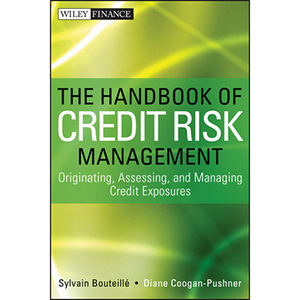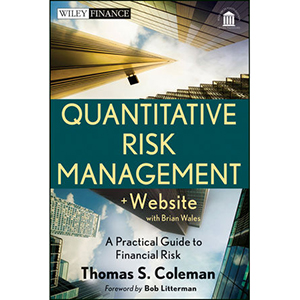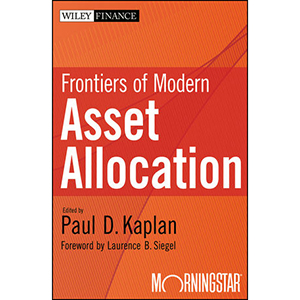| Socially Responsible Finance and Investing Posted: 13 Mar 2013 04:51 AM PDT 
Book Description A detailed look at the role of social responsibility in finance and investing The concept of socially responsible finance and investing continues to grow, especially in the wake of one of the most devastating financial crises in history. This includes responsibility from the corporate side (corporate social responsibility) as well as the investor side (socially responsible investing) of the capital markets. Filled with in-depth insights and practical advice, Socially Responsible Finance and Investing offers an important basis of knowledge regarding both the theory and practice of this ever-evolving area of finance. As part of the Robert W. Kolb Series in Finance, this book showcases contributed chapters from professionals and academics with extensive expertise on this particular subject. It provides a comprehensive view of socially responsible foundations and their applications to finance and investing as determined by the current state of research. - Discusses many important issues associated with socially responsible finance and investing, like moral hazard and the concept of “too big to fail”
- Contains contributed chapters from numerous thought-leaders in the field of finance
- Presents comprehensive coverage starting with the basics and bringing you through to cutting-edge, current theory and practice
Now more than ever, we need to be mindful of the social responsibilities of all investment practices. The recent financial crisis and recession has changed the financial landscape for years to come and Socially Responsible Finance and Investing is a timely guide to help us navigate this difficult terrain. Table of Contents
Chapter 1. Socially Responsible Finance and Investing: An Overview Part I: Foundations and Key Concepts
Chapter 2. Stakeholder Analysis
Chapter 3. Corporate Social Responsibility
Chapter 4. Business Models and Social Entrepreneurship
Chapter 5. Fiduciary and Other Legal Duties
Chapter 6. International and Cultural Views Part II: Finance and Society
Chapter 7. Social, Environmental, and Trust Issues in Business and Finance
Chapter 8. Religion and Finance
Chapter 9. Social Finance and Banking
Chapter 10. Managerial Compensation
Chapter 11. Externalities in Financial Decision Making
Chapter 12. Real Estate and Society
Chapter 13. Federal Housing Policies and the Recent Financial Crisis
Chapter 14. Predatory Lending and Socially Responsible Investors
Chapter 15. Use and Misuse of Financial Secrecy in Global Banking Part III: Corporate Engagement
Chapter 16. Corporate Social Responsibility and Corporate Governance
Chapter 17. Measuring Responsibility to the Different Stakeholders
Chapter 18. Corporate Philanthropy
Chapter 19. Institutional Investor Activism
Chapter 20. Social Activism and Nongovernmental Organizations Part IV: Socially Responsible Investing
Chapter 21. Corporate Socially Responsible Investments
Chapter 22. SRIMutual Fund and Index Performance
Chapter 23. Performance Implications of SR Investing: Past versus Future
Chapter 24. Money-Flows of Socially Responsible Investment Funds around theWorld Book Details - Hardcover: 515 pages
- Publisher: Wiley (September 2012)
- Language: English
- ISBN-10: 1118100093
- ISBN-13: 978-1118100097
Note: There is a file embedded within this post, please visit this post to download the file. Related Books The post Socially Responsible Finance and Investing appeared first on Wow! eBook. |
| The Handbook of Credit Risk Management Posted: 13 Mar 2013 04:47 AM PDT 
Book Description A comprehensive guide to credit risk management The Handbook of Credit Risk Management presents a comprehensive overview of the practice of credit risk management for a large institution. It is a guide for professionals and students wanting a deeper understanding of how to manage credit exposures. The Handbook provides a detailed roadmap for managing beyond the financial analysis of individual transactions and counterparties. Written in a straightforward and accessible style, the authors outline how to manage a portfolio of credit exposures–from origination and assessment of credit fundamentals to hedging and pricing. The Handbook is relevant for corporations, pension funds, endowments, asset managers, banks and insurance companies alike. - Covers the four essential aspects of credit risk management: Origination, Credit Risk Assessment, Portfolio Management and Risk Transfer.
- Provides ample references to and examples of credit market services as a resource for those readers having credit risk responsibilities.
- Designed for busy professionals as well as finance, risk management and MBA students.
As financial transactions grow more complex, proactive management of credit portfolios is no longer optional for an institution, but a matter of survival. Table of Contents
Part I: Origination
Chapter 1. Fundamentals of Credit Risk
Chapter 2. Governance
Chapter 3. Checklist for Origination Part II: Credit Assessment
Chapter 4. Measurement of Credit Risk
Chapter 5. Dynamic Credit Exposure
Chapter 6. Fundamental Credit Analysis
Chapter 7. Alternative Estimations of Credit Quality Part III: Portfolio Management
Chapter 9. Credit Portfolio Management
Chapter 10. Economic Capital and Credit Value at Risk (CVaR)
Chapter 11. Regulation
Chapter 12. Accounting Implications of Credit Risk Part IV: Mitigation and Transfer
Chapter 13. Mitigating Derivative Counterparty Credit Risk
Chapter 14. Structural Mitigation
Chapter 15. Credit Insurance, Surety Bonds, and Letters of Credit
Chapter 16. Credit Derivatives
Chapter 17. Collateral Debt Obligations (CDOs)
Chapter 18. Bankruptcy Book Details - Hardcover: 352 pages
- Publisher: Wiley (December 2012)
- Language: English
- ISBN-10: 1118300203
- ISBN-13: 978-1118300206
Note: There is a file embedded within this post, please visit this post to download the file. Related Books The post The Handbook of Credit Risk Management appeared first on Wow! eBook. |
| Quantitative Risk Management, +Website Posted: 13 Mar 2013 04:42 AM PDT 
Book Description State of the art risk management techniques and practices—supplemented with interactive analytics All too often risk management books focus on risk measurement details without taking a broader view. Quantitative Risk Management delivers a synthesis of common sense management together with the cutting-edge tools of modern theory. This book presents a road map for tactical and strategic decision making designed to control risk and capitalize on opportunities. Most provocatively it challenges the conventional wisdom that “risk management” is or ever should be delegated to a separate department. Good managers have always known that managing risk is central to a financial firm and must be the responsibility of anyone who contributes to the profit of the firm. A guide to risk management for financial firms and managers in the post-crisis world, Quantitative Risk Management updates the techniques and tools used to measure and monitor risk. These are often mathematical and specialized, but the ideas are simple. The book starts with how we think about risk and uncertainty, then turns to a practical explanation of how risk is measured in today’s complex financial markets. - Covers everything from risk measures, probability, and regulatory issues to portfolio risk analytics and reporting
- Includes interactive graphs and computer code for portfolio risk and analytics
- Explains why tactical and strategic decisions must be made at every level of the firm and portfolio
Providing the models, tools, and techniques firms need to build the best risk management practices, Quantitative Risk Management is an essential volume from an experienced manager and quantitative analyst. Table of Contents
Part I: Managing Risk
Chapter 1. Risk Management versus Risk Measurement
Chapter 2. Risk, Uncertainty, Probability, and Luck
Chapter 3. Managing Risk
Chapter 4. Financial Risk Events
Chapter 5. Practical Risk Techniques
Chapter 6. Uses and Limitations of Quantitative Techniques Part II: Measuring Risk
Chapter 7. Introduction to Quantitative Risk Measurement
Chapter 8. Risk and Summary Measures: Volatility and VaR
Chapter 9. Using Volatility and VaR
Chapter 10. Portfolio Risk Analytics and Reporting
Chapter 11. Credit Risk
Chapter 12. Liquidity and Operational Risk
Chapter 13. Conclusion Book Details - Hardcover: 558 pages
- Publisher: Wiley (April 2012)
- Language: English
- ISBN-10: 1118026586
- ISBN-13: 978-1118026588
Note: There is a file embedded within this post, please visit this post to download the file. Related Books The post Quantitative Risk Management, +Website appeared first on Wow! eBook. |
| Private Equity Operational Due Diligence Posted: 13 Mar 2013 04:35 AM PDT 
Book Description A step-by-step guide to develop a flexible comprehensive operational due diligence program for private equity and real estate funds Addressing the unique aspects and challenges associated with performing operational due diligence review of both private equity and real estate asset classes, this essential guide provides readers with the tools to develop a flexible comprehensive operational due diligence program for private equity and real estate. It includes techniques for analyzing fund legal documents and financial statements, as well as methods for evaluating operational risks concerning valuation methodologies, pricing documentation and illiquidity concerns. - Covers topics including fund legal documents and financial statement analysis techniques
- Includes case studies in operational fraud
- Companion website includes sample checklists, templates, spreadsheets, and links to laws and regulations referenced in the book
- Equips investors with the tools to evaluate liquidity, valuation, and documentation
- Also by Jason Scharfman: Hedge Fund Operational Due Diligence: Understanding the Risks
Filled with case studies, this book is required reading for private equity and real estate investors, as well as fund managers and service providers, for performing due diligence on the noninvestment risks associated with private equity and real estate funds. Table of Contents
Chapter 1. Introduction to Private Equity Operational Risk
Chapter 2. Importance of Operational Due Diligence for Private Equity Funds
Chapter 3. Beginning the Operational Due Diligence Review: Core Issues
Chapter 4. Additional Operational Due Diligence Considerations: An Expanded Analysis
Chapter 5. Valuation Techniques, Methodologies, and Standards
Chapter 6. Legal Due Diligence
Chapter 7. Financial Statement Due Diligence
Chapter 8. Distinguishing the Assets Class: Real Estate–Specific Concerns
Chapter 9. Putting It All Together: Asset Allocation and Ongoing Monitoring
Chapter 10. Boards, Committees, and Activism
Chapter 11. Case Studies and Scenarios
Chapter 12. Trends and Future Developments Book Details - Hardcover: 371 pages
- Publisher: Wiley (March 2012)
- Language: English
- ISBN-10: 111811390X
- ISBN-13: 978-1118113905
Note: There is a file embedded within this post, please visit this post to download the file. Related Books The post Private Equity Operational Due Diligence appeared first on Wow! eBook. |
| Frontiers of Modern Asset Allocation Posted: 13 Mar 2013 04:30 AM PDT 
Book Description Innovative approaches to putting asset allocation into practice Building on more than 15 years of asset-allocation research, Paul D. Kaplan, who led the development of the methodologies behind the Morningstar Rating(TM) and the Morningstar Style Box(TM), tackles key challenges investor professionals face when putting asset-allocation theory into practice. This book addresses common issues such as: - How should asset classes be defined?
- Should equities be divided into asset classes based on investment style, geography, or other factors?
- Should asset classes be represented by market-cap-weighted indexes or should other principles, such as fundamental weights, be used?
- How do actively managed funds fit into asset-class mixes?
Kaplan also interviews industry luminaries who have greatly influenced the evolution of asset allocation, including Harry Markowitz, Roger Ibbotson, and the late Benoit Mandelbrot. Throughout the book, Kaplan explains allocation theory, creates new strategies, and corrects common misconceptions, offering original insights and analysis. He includes three appendices that put theory into action with technical details for new asset-allocation frameworks, including the next generation of portfolio construction tools, which Kaplan dubs “Markowitz 2.0.” Table of Contents
Part I: Equities
Chapter 1. Purity of Purpose: How Style-Pure Indexes Provide Useful Insights
Chapter 2. Investing in Europe with Style: Why Investors in Europe Would Benefit From Constructing Portfolios Through the Prism of Style
Chapter 3. Why Fundamental Indexation Might—or Might Not—Work
Chapter 4. The Fundamental Debate: Two Experts Square Off on the Big Issues Surrounding Fundamentally Weighted Indexes
Chapter 5. Collared Weighting: A Hybrid Approach to Indexing
Chapter 6. Yield to Investors? A Practical Approach to Building Dividend Indexes
Chapter 7. Holdings-Based and Returns-Based Style Models
Chapter 8. Estimates of Small Stock Betas Are Much Too Low
Chapter 9. A Macroeconomic Model of the Equity Risk Premium Part II: Fixed Income, Real Estate, and Alternatives
Chapter 10. Good and Bad Monetary Economics, and Why Investors Need to Know the Difference
Chapter 11. Inflation, Gilt Yields, and Economic Policy
Chapter 12. Reverse Mean-Variance Optimization for Real Estate Asset-Allocation Parameters
Chapter 13. The Long and Short of Commodity Indexes
Chapter 14. Less Alpha and More Beta Than Meets the Eye
Chapter 15. Venture Capital and its Role in Strategic Asset Allocation Part III: Crashes and Fat Tails
Chapter 16. One-and-a-Quarter Centuries of Stock Market Drawdowns
Chapter 17. Stock Market Bubbles and Crashes: A Global Historical and Economic Perspective
Chapter 18. De´ ja` Vu All Over Again
Chapter 19. De´ ja` Vu Around the World
Chapter 20. Getting a Read on Risk: A Discussion with Roger Ibbotson, George Cooper, and Benoˆıt Mandelbrot on the Crisis and Risk Models Part IV: Doing Asset Allocation
Chapter 21. Does Asset-Allocation Policy Explain 40 Percent, 90 Percent, or 100 Percent of Performance?
Chapter 22. Asset-Allocation Models Using the Markowitz Approach
Chapter 23. Asset Allocation with Annuities for Retirement Income Management
Chapter 24. MPT Put Through the Wringer: A Debate Between Steven Fox and Michael Falk
Chapter 25. Updating Monte Carlo Simulation for the Twenty-First Century
Chapter 26. Markowitz 2.0
Chapter 27. What Does Harry Markowitz Think? A Discussion with Harry Markowitz and Sam Savage Book Details - Hardcover: 384 pages
- Publisher: Wiley (December 2011)
- Language: English
- ISBN-10: 1118115066
- ISBN-13: 978-1118115060
Note: There is a file embedded within this post, please visit this post to download the file. Related Books The post Frontiers of Modern Asset Allocation appeared first on Wow! eBook. |
| The Complete Guide to Portfolio Construction and Management Posted: 13 Mar 2013 04:25 AM PDT 
Book Description In the wake of the recent financial crisis, many will agree that it is time for a fresh approach to portfolio management. The Complete Guide to Portfolio Construction and Management provides practical investment advice for building a robust, diversified portfolio. Written by a high-profile investment adviser, this book reveals a practical portfolio management framework and new approach to portfolio construction based on four key market forces: macro, fundamental, technical, and behavioural. It is an insight that takes the focus off numbers, looking instead at the role of risk and behavior in finance. As we have seen with the recent finance meltdown, traditional portfolio management techniques are flawed. Investors need to understand those flaws and learn how to incorporate risk management and behavioral finance into their asset management strategies. With a foreword by industry leader Francois-Serge L’habitant, this is your one-stop guide, with new ways for you to manage, grow and preserve your investment portfolio, even in uncertain markets. Table of Contents
PART I: INVESTORS AND RISK
Chapter 1. Basic Principles
Chapter 2. Measures of Risk PART II: ASSET CLASSES AND THEIR DEGREE OF RISK
Chapter 3. Asset Classes and Associated Risks
Chapter 4. Particular Forms of Investment within Asset Classes
Chapter 5. Classification of Asset Classes According to their Degree of Risk PART III: THE MARKET
Chapter 6. Market Efficiency
Chapter 7. Fundamental Analysis
Chapter 8. Technical Analysis
Chapter 9. Investment Approach Based on "Psychological Principles" PART IV: VALUATION OF FINANCIAL ASSETS
Chapter 10. Valuation of Money Market Investments PART V: THREE PRACTICAL APPROACHES TO SECURITY SELECTION: BUFFETT, GRAHAM AND LYNCH
Chapter 17. Warren Buffett's Value Investing Approach
Chapter 18. Benjamin Graham's Approach
Chapter 19. Peter Lynch's Approach PART VI: BEHAVIOURAL FINANCE
Chapter 20. Investors in Behavioural Finance
Chapter 21. Heuristics and Cognitive Biases
Chapter 22. Investment Approach Based on Behavioural Finance PART VII: FORECASTING MARKET MOVEMENTS
Chapter 24. Investment Approach Based on Probabilities
Chapter 25. Random Walk Theory
Chapter 26. Market Timing
Chapter 27. Macroeconomic Investment Approach PART VIII: MODELLING MARKET MOVEMENTS
Chapter 28. Suggested Investment Approach
Chapter 29. The Forces PART IX: PORTFOLIO CONSTRUCTION AND MANAGEMENT
Chapter 32. Modern Portfolio Theory According to Markowitz
Chapter 33. The Capital Asset Pricing Model (CAPM)
Chapter 34. The Minimum Variance Portfolio
Chapter 35. Value-at-Risk (VaR)
Chapter 36. Discretionary Mandates
Chapter 37. The Dollar-cost Averaging Approach
Chapter 38. Our Portfolio Construction Method PART X: ATTRACTIVENESS OF THE DIFFERENT ASSET CLASSES
Chapter 39. Asset Classes
Chapter 40. The Four Forces of the Investment Model
Chapter 41. Table Summarising the Different Forces
Chapter 42. A Final Example: Analysis of the Subprime Crisis Book Details - Hardcover: 310 pages
- Publisher: Wiley (January 2012)
- Language: English
- ISBN-10: 111997688X
- ISBN-13: 978-1119976882
Note: There is a file embedded within this post, please visit this post to download the file. Related Books The post The Complete Guide to Portfolio Construction and Management appeared first on Wow! eBook. |








Tidak ada komentar:
Posting Komentar